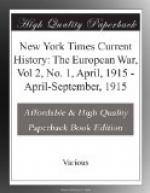Our Captain by these lectures gave us an insight into the second great German blunder after the failure to occupy Paris, which was the failure immediately to swing a line across Northern France, thus cutting off Calais and Boulogne, where they could really have leveled a pistol at England’s head. He explained that it was the superiority of the French cavalry that dictated that the line should instead run straight north through the edge of Belgium to the sea. His explanations went further than this, for he refuted many military arguments to the effect that cavalry became obsolete with the advent of aeroplanes.
Cavalry formerly was used to screen the infantry advance and also for shock purposes in the charges. Now that the lines are established, it is mostly used with the infantry in the trenches; but in the great race after the Marne to turn the western flanks it was the cavalry’s ability to outstrip the infantry that kept the Germans from practically all of Northern France. In other words, the French chausseurs, more brilliant than the Uhlans, kept that northern line straight until the infantry corps had time to take up position.
My introduction to the real French Army was made at the point of junction with the English troops, so I was thus able to make some comparison between the types of the Allies. I did not see the Germans except as prisoners, although on this trip I was sometimes within a few yards of their lines. With all consideration for the statement that they are the greatest fighting machine the world has ever seen, all I can say is that the greatest fighting machine I have even seen is the French Army.
To me they seem invincible from the standpoints of power, intelligence, and humanity. This latter quality specially impressed me. I do not believe any army with such high ideals can easily be beaten, and I judge not only from Generals in command, but the men in the trenches. One morning I was going through the trenches near the most important point where the line was continually under fire.
Passing from the second line to a point less than a hundred yards from the German rifles I came face to face with a General of division. He was sauntering along for the morning’s stroll he chose to take in the trenches with his men rather than on the safer roads at the rear. He smoked a cigarette and seemed careless of danger. He continually patted his soldiers on the back as he passed and called them “his little braves.”
I could not help wondering whether the German General opposite was setting his men the same splendid example. I inquired the French General’s name; he was General Fayolle, conceded by all the armies to be the greatest artillery expert in the world. Comradeship between officers and men always is well known in the French Army, but I never before realized how the officers were so willing to accept quite the same fate.
In Paris the popular appellation for a German is “boche.” Not once at the front did I hear this word used by officers or men. They deplore it, just as they deplore many things that happen in Paris. Every officer I talked to declared the Germans were a brave, strong enemy; they waste no time calling them names.




